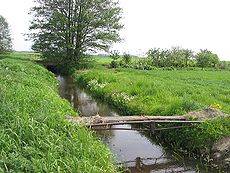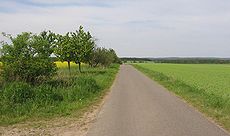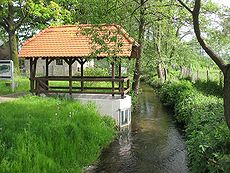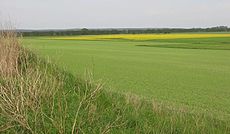Baitz
|
Baitz
City of Brück
Coordinates: 52 ° 10 ′ 33 ″ N , 12 ° 40 ′ 35 ″ E
|
|
|---|---|
| Residents : | 186 (Aug 6, 2015) |
| Incorporation : | January 31, 2002 |
|
Farm in the village
|
|
The street village of Baitz is part of the town of Brück in the Brandenburg district of Potsdam-Mittelmark . The place with 186 inhabitants (2015) belongs to the nature park Hoher Fläming and is located in the Baruther glacial valley on the southern edge of the nature reserve Belziger Landschaftswiesen , a rare flow-through moor in Brandenburg .
The nature reserve of the 4,500 hectare sanctuary is located in Baitz . The station is also a branch of the state bird sanctuary of the state of Brandenburg in Buckow and has dedicated itself in particular to the protection of the endangered Great Bustard ( Otis tarda ). The natural integration of the place and the requirements of nature protection largely determine the economic life of the village today. Historically, Baitz is part of the border area that was disputed between Saxony and Brandenburg until 1815 .
Location and natural space
Belziger Vorflaming and neighboring villages
The village of Baitz is located away from busy roads and industrial business areas in the middle distance between Brück and Bad Belzig in a small valley that the Baitzer Bach cut into the hills of Belziger Vorflming. The chain of hills Heideberg (96 meters) - Fuchsberg (64 meters) - Räuberberge (68 meters) narrows the glacial valley from eight kilometers in the area of the Belziger landscape meadows to three kilometers in the passage at Brück. The lowland location Landschaftswiesen has an altitude of 40 to 44 meters above sea level .
To the west, a small country road connects the place with the village of Schwanebeck , which, like its north-western neighbor Fredersdorf and the south-western and south-eastern neighboring villages of Lüsse and Neschholz, belong to the district town of Bad Belzig. Baitz near Neschholz has a connection to the federal highway 246 via a country road . The villages Trebitz and Gömnigk , which are part of the municipality of Brück, are to the east of the place at the breakthrough of the tarpaulin through the chain of hills . Baitz is a stop on the Berlin – Blankenheim railway line (part of the so-called Kanonenbahn ) . The regional express (RE 7) runs every hour to Berlin and Bad Belzig and every two hours to Dessau (from Bad Belzig).
Baitzer Bach

In addition to the church, farms and some settlement houses, the villagescape is determined by the Baitzer Bach, to which the village gave its name. The largely natural body of water rises in the Belziger Vorfläming south of Kuhlowitz in the Kuhlowitz district of Preußnitz , flows past Lüsse and then through Baitz. To the north of Baitz, the brook reaches the landscape meadows, which it flows through surprisingly quickly in view of the flat valley. After a flow length of around 16 kilometers, it flows into the Belziger / Fredersdorfer Bach - shortly before it flows into the Plane , whose water in turn reaches the Elbe via the Havel . A second source is located south of Neschholz, whose source arm, called Streckerbach , is roughly the same length as the main arm and joins it in Baitz. On a scale from one to five, Rolf Scharf and Dietrich Braasch gave the stream a protection level of three in a study of the sensitive flowing waters in Brandenburg .
history
Slavic naming
The first written mention of Baitz, in old spelling Boghetiz , Boycz or Batz , took place in 1313 under the name Boghetiz . Reinhard E. Fischer (1970) derives the name of Polabisch Bogutici = people of Boguta from. The name refers to the Slavic settlement of the area before the founding of the Mark Brandenburg by Albrecht the Bear in 1157. The name of the main town Brück, on the other hand, is - not entirely certain - mostly assigned to the city of Bruges and thus comes from the time of the state expansion by the first Ascanian margraves who, as part of their skillful settlement policy, also called Flemings to the country. After the Flemings and their villages, the Vlämlingen , the entire region was named Fläming in the first half of the 19th century .
Historic border area
Baitz did not remain under Brandenburg sovereignty for long, because the village lies in an area that has been disputed for centuries, the ownership of which has changed between the Margraviate of Meissen , the Margraviate of Brandenburg and the Archdiocese of Magdeburg . It was not until the Congress of Vienna in 1815 that Baitz and Brück finally fell to Prussia . Up until this point in time, the Belziger landscape meadows formed the border between the Kingdom of Saxony and the Mark Brandenburg and the town of Brück was the north-eastern border town. A post-milestone pillar in Saxony still stands in Brück today as an eloquent stone testimony to the Saxon past. The strategic importance of Brück resulted from the narrowness in the swampy glacial valley, which was used early on as a transition from Belziger Vorfläming to Zauche . Trade routes and a military road, which secured a castle that no longer existed, led along here.
Wiesenau desert and hunting lodge
In the Middle Ages, the village of Baitz comprised the deserted village of Wiesenau. In 1565 the farmers in Baitz owned 21 village hooves and 16 hooves of the desert village of Wiesenau. In 1591, a total of 38 hooves including parish hooves are recorded. While some Flämingdörfer were already abandoned in the 13th century (some in the late 12th century) after the rapid establishment of localities in the 12th century, Wiesenau fell into desolation after 1427 according to Reinhard E. Fischer . The settlement on a meadow floodplain is documented in 1383 as zcu Visenow , 1388 as ffissenow and around 1500 from wusten wißnaw … wießenaw .
East of the Heideberg, halfway between Baitz and Lüsse, the former forester's house, which is shown on many maps as Forsthaus Wiesenau , reminds of the desert with its name, even if it has belonged to the Deutsche Reichsbahn for a long time and is now in private hands. The building was built around 1900 as a hunting lodge and has two preserved towers on the portal side, which are made of brick .
Incorporation
Baitz was incorporated into Brück on January 31, 2002.
economy
Agriculture on and in the nature reserve
The location on the edge of the Belziger landscape meadows determines the specific characteristics of the traditional economic system, agriculture, in the northern areas of Baitz today . Characteristic is the integration of the management in the nature conservation ordinance Belziger Landschaftswiesen under the term of contractual nature conservation . With 2,461 hectares, a little more than half of the nature reserve is available for agricultural use for arable farming , as pasture and for hay production . The economic interests are brought into harmony with the requirements of nature conservation , for example by dividing this area again into three zones with different usage restrictions. The arable land, on the other hand, is partly based on medieval multi-field farming with alternating strips of grain, peas, lupins, rape, clover and potatoes, because the resulting mosaic of rotational and permanent fallow land provides the great bustard with the ecologically necessary breeding and feeding areas (cf. in detail Belziger landscape meadows , chapter "Nature Conservation as Interest Management" and "Meadow and Landscape Management").
tourism
The natural integration of the village in the Hoher Fläming Nature Park and the connection to the bird paradise with the tranquility and expanse of the landscape meadows have led to increased tourist demand in recent years , which, for example, takes account of an extensive, well-signposted network of trails. An expression of the upswing in tourism is also an extensive riding stables with breeding operations , riding training and holiday apartments . In addition, the Baitz conference center with seminar room and accommodation was built in 1990/1992 on a restored farm in the Brandenburg region. On a 4,000 m² site with horses and petting animals, the house is also an attraction for children. And the state bird sanctuary is also geared towards visitors with its show garden, demonstrations and guided tours.
Nature conservation station Baitz
Facility and bird sanctuary
The Baitz nature conservation station has existed since 1990 when it moved into a converted and renovated homestead. It is an institution of the State Environment Agency Brandenburg and a branch of the State Bird Protection Station of the State of Brandenburg in Buckow in Havelland . In the extensive garden area, aviaries for the care of injured birds of prey , flower beds, a pond and an orchard meadow create the conditions for environmental educational work, especially with children and young people. In 1998 the station opened an information and exhibition building which, in addition to broad-based public relations work, also offers good working and research conditions for diploma and doctoral students .
Further research and observation possibilities exist in a field station, which was built in 1993 from a converted pasture center deep in the Belziger landscape meadows. The non-public station resembles a bungalow. Contrary to some statements to the contrary, it is not a bird observation tower. The so far only observation tower of the landscape meadows is located near Freienthal on the edge of the sanctuary and is accessible to everyone from Freienthal.
European bird sanctuary
As a SPA = Special Protection Area, the Belziger Landschaftswiesen nature reserve is part of the European bird sanctuary Unteres Rhinluch, Dreetzer See, Havelländisches Luch and Belziger Landschaftsweise in the Natura 2000 protected area system . Counts at the beginning of the 21st century listed a total of around 160 bird species, including 110 meadow breeders. 30 of these birds are on Germany's Red List of Endangered Species .
These include, for example, the corncrake ( Crex crex ; also meadow rail ), a bird that is threatened with extinction in some Central European countries and threatened worldwide. The family of Plover represents, among others, the lapwing ( Vanellus vanellus ), who also endangered bird of the year 1996. In the summer of 1999 saw the first time in the recent history of the natural landscape meadows to outstanding mass roost of pipe and Harriers . According to a report by Torsten Ryslavy showed counts 108 pipe ( Circus aeruginosus ) and 18 Montagu's Harrier ( Circus pygargus ) - a remarkable magnitude for Europe specially protected and in Germany endangered birds of prey.
In addition to the preservation and promotion of these bird populations and other meadow breeders, the Baitz nature conservation station is working on a special project to reintroduce kestrels ( Falco tinnunculus ) and little owls ( Athene noctua ). The flow moor of the landscape meadows is also a preferred migratory, resting and wintering area for migratory birds . The main focus of nature conservationists, however, is on the Brandenburg ostrich , the great bustard ( Otis Tarda ).
Central task of the station
The central task of the station is therefore the development and implementation of the great bustard species protection program in the area of the Belziger landscape meadows. The 4,500 hectare nature reserve is the most important occurrence area in the Federal Republic of Germany along with Buckow. One focus of the measures is the control and management of the contractual nature protection areas mentioned above from the point of view of optimal great bustard and meadow breeder protection [...].
While in the middle of the 20th century there were still around 4,000 of the bustards, which weigh up to 18 kilograms and are among the heaviest birds in the world after the giant bustards ( Ardeotis kori ), this population had shrunk to around 150 nationwide in 2003, from which around 30 lived in the landscape meadows. According to Norbert Eschholz, head of the station, the population in March 2006 was 37 birds and the trend is still increasing. However, this stock can currently only be achieved with the aid of artificial incubation . Clutches that don't stand a chance outside are picked up and artificially incubated. The hatched chicks are reared in the protective enclosure of the Buckow Central Station and the young birds are returned to the landscape meadows when they are five weeks old . For more information on the design and successes of the bustard protection program, see Belziger Landschaftswiesen, chapter European bird sanctuary .
Guided tours and access to the reserve

The employees of the nature conservation station organize tours of the protected area by arrangement. Individual hikes in the area are always possible, regardless of the starting point, until signs prohibit passage. A particularly scenic path leads from the village along the Baizer Bach deep into the landscape meadows and gives a clear idea of the nature of the area even before it is forbidden to walk through. The asphalt bike path between Baitz and Trebitz, which runs on the northern slope of Fuchsberg and Räuberbergen in a slightly elevated position right on the edge of the meadows, offers a particularly good overview of the wide, flat landscape. The car-free route is part of the approximately 915-kilometer-long R1 European Cycle Route .
Even with the expert guidance of the conservationists, however, it is very unlikely to see a great bustard , as the heavy, shy birds have a long flight distance that they can perceive people long before they notice them. In the hunter's Latin it is therefore said that bustards have an eye on every feather .
Village church
The Protestant village church is a rectangular building with a retracted west tower, the face of which today is marked by extensive renovations in 1913. Since the walls are largely made of square stone and the north wall has remains of the late Romanesque predecessor building, Theo Engeser and Konstanze Stehr included the house as a stone church in their directory of medieval village churches in the Potsdam-Mittelmark district. The current building is likely to be the fourth, including a first wooden church, and still contains remains of the first stone building, which could have been made towards the end of the 12th century, i.e. shortly after the founding of the Margraviate of Brandenburg. The three-part basic structure consisted of the nave , a retracted choir and the apse ; The choir and apse are no longer there today.
Since the official visitors did not register an intact church, the first stone building must have been destroyed before their visit in 1530. The church was rebuilt 17 years later, and this building was probably extended with the sacrifice of the choir and apse. In 1636 during the Thirty Years' War the building was destroyed again by Swedish troops. The building, which was restored in 1661, probably had a lattice tower made of bricks with a solid west wall. The renovations in 1913 completely changed the image of the church: for example, the south wall was completely renewed, the north wall was raised, the tower was redesigned and a small ridge was added to the roof ridge . A comprehensive renovation took place in 1991.
Today the tower has a steep gable roof with large dormer windows . The gabled roof of the ship is on the north side of stone interlocking tiles and on the south side of plain tiles . Narrow segmental arches dominate the windows. Overall, neo-Romanesque forms of jewelry predominate .
literature
- Bärbel Litzbarski: The European Bird Sanctuary (SPA) Belziger Landschaftswiesen. In: Nature conservation and landscape management in Brandenburg - contributions to ecology, nature and water protection. Landesumweltamt Brandenburg (Ed.), Vol. 7, Issue 3, 1998, pp. 182-184.
- Torsten Ryslavy: Outstanding mass sleeping place for marsh harriers in the European bird sanctuary (SPA) Belziger Landschaftswiesen in 1999. In: Nature conservation and landscape maintenance in Brandenburg - contributions to ecology, nature and water protection. Landesumweltamt Brandenburg (Ed.), Vol. 9, Issue 4, 2000, pp. 136-139.
Web links
- Theo Engeser, Konstanze Stehr: Baitz village church . In addition to the footnotes directly given, the section “Feldsteinkirche” is completely based on information from Engeser / Stehr
- Office Brück, information brochure (PDF; 9.75 MB)
Individual evidence
- ^ Rolf Scharf, Dietrich Braasch: The sensitive flowing waters of the state of Brandenburg, 4th contribution to their recording and evaluation. In: Nature conservation and landscape management in Brandenburg - contributions to ecology, nature and water protection. Landesumweltamt Brandenburg (Ed.), Vol. 8, Issue 2, 1999 pp. 44–53.
- ↑ a b c Theo Engeser, Konstanze Stehr: Baitz village church
- ^ Reinhard E. Fischer, Jürgen Neuendorf, Joachim Reso: Around Belzig. Place and field names, boulders and trees, streams and ponds. (= Förderkreis Museum Burg Eisenhardt Belzig eV (Ed.): Book 4 on City History. ) The foreword is from 1997. OCLC 76332674 , p. 40.
- ↑ Information given by telephone on June 16, 2006 from Ms. Block from the Baitz nature reserve and the current owner of the former forester's house.
- ↑ StBA: Changes in the municipalities in Germany , see 2002
- ↑ Riding stables
- ^ Baitz conference center
- ↑ a b H. Meckelmann, N. Eschholz: Ten years of nature conservation station in Baitz. In: Nature conservation and landscape management in Brandenburg - contributions to ecology, nature and water protection. State Environment Agency Brandenburg (Ed.), Vol. 9, Issue 3, 2000, p. 114.
- ↑ Belziger landscape meadows
- ↑ Telephone information from Norbert Eschholz, head of the state bird sanctuary in Baitz, March 29, 2006.











